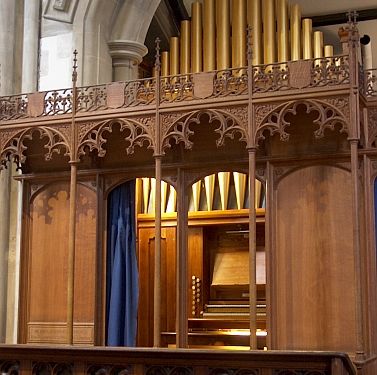
The College was originally founded by Bishop Francis James Chavasse (1846-1928), and his son Christopher Maude Chavasse (1884-1962), later Bishop of Rochester, with the aim of providing a low-cost Oxford education for promising students of limited means.
Over the years, through the support of alumni and generous benefactors, St Peter’s is now an established and thriving College of the University, being granted collegiate status in 1961. Women were admitted for the first time in 1979 and student numbers, including post-graduates, have now risen to over 400.
‘Father’ Willis built the college’s organ in 1875, just as he was rising to the height of fame with organs such as those for the Royal Albert Hall and Alexandra Palace. While of modest size, it was built to the same high standard with Willis’s characteristically bold and unique voicing, tracker key and pneumatic pedal action.
In the 1890s, the college turned to a local builder, Martin of Oxford, to enlarge the Swell and add a Pedal Open Metal 16ft stop. Little else was done to the organ for 110 years, by which time it had fallen into disuse and presented a very sorry sight. Thick black paint had been daubed over the console and visible timbers in an attempt to ‘ebonise’. Rarely have we seen such heavily worn action parts. Willis’s pipework had been robbed of its brilliance by the combined effects of re-voicing, dirt and incorrect wind pressure. The usual problems of perished leather, split soundboards and an inadequate blower were all too evident.
The Alumni and Friends of St Peter’s College generously decided to fund a restoration with Dr William McVicker as consultant and Nicholson & Co as organ builders. Restoration projects bring their own technical problems and difficult choices; Willis’s work would be restored and Martin’s useful additions retained but the long-standing problems they introduced would be addressed. Tightly packed pedal open pipes blocked sound egress from Willis’s side case so the pipes were brought forward, spaced more widely and the smallest two placed behind.
The four-stop clamp added to the Swell soundboard had overburdened Willis’s pallets despite their large size and weighty touch. The pallets were enlarged and re-proportioned to give a firm but pleasant touch while retaining all the original action components and geometry. Paint was stripped from the console and the case to reveal the original grain. Case pipes were re-gilded. Manual keys were recovered in reclaimed ivory. A thick veneer of reclaimed pitch pine on the stop jambs now hides timbers defaced by switches, lights and drawing pins. Leather and lead tubing were replaced like-for-like. Hand blowing equipment was restored to working order, a new blower delivers ample wind and a humidifier protects all from climatic damage.
When the work was finished, Dr Roger Allen, Tutor in Music, wrote to Dr William McVicker, “I am spending some happy hours this week playing the restored Willis. This is one of the most successful restorations I have ever encountered and I think you have done a wonderful job as adviser. Thank you so much. The Great chorus work is just fabulous: wonderfully clear and bright without being in any way strident. The action is crisp and responsive. What a joy!”

